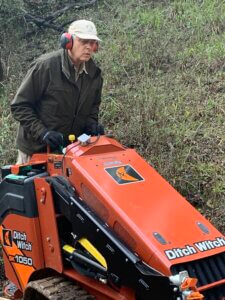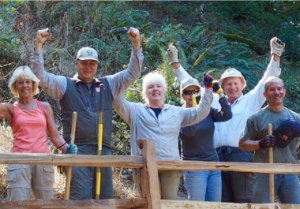
Lessons from the Trail Boss
Master trail-builder Ed Westbrook shares key takeaways from building trails at China Camp.
In a county famous for its trails, China Camp’s 15 miles of multi-use trails stand out. Open to all—hikers, runners, mountain bikers, and equestrians—the popular network is regularly lauded by park visitors for their excellent condition, especially given the trails’ heavy use. What’s the China Camp secret?
It’s Ed Westbrook. By day the founder and CEO of Quarry House, a company that designs, fabricates, and installs custom stonework for projects worldwide. Ed is also a park neighbor and long-time member of the Friends of China Camp board.

Over the years, Ed had helped build trails in some pretty notable places—think Yellowstone, Yosemite, and the San Francisco AIDS Memorial. So, back in 2012, when the state threatened to close China Camp and FOCC took over park operations, Ed assumed the role of “trail boss.” He leveraged his considerable construction and leadership skills to train a team of volunteers—many of whom had never used machinery bigger than a lawnmower. Now this team of self-dubbed “crazies,” following the guidance and leadership of Trail Boss Ed, doesn’t flinch at even the most challenging trailwork, be it smoothing out switchbacks or configuring a trail to meet the exacting standards of the Americans With Disabilities Act.
In his tenure on our trails, Ed has come up with some significant takeaways on his experience at China Camp, and why our gang of crazies has been able to maintain such an outstanding trail network for over a decade.
- There’s no one way to build a trail.
With his experience at national parks, Ed was familiar with meeting state and federal standards to build a trail. At China Camp, while the state still operated the park, Ed worked with the state staff and the California Conservation Commission (CCC) crews. He also familiarized himself with the state’s trail-building manual.
“What I quickly learned,” notes Ed, “is that there is no single way to build a trail. On-site conditions play a significant role in determining the equipment and materials needed for a given job.” At China Camp, that would mean the site itself and the scale of the project would determine the best ways to build the trail. “They use dynamite at Yosemite,” Ed adds—great for busting up granite boulders but not a technique that would make sense at China Camp.
- The learning curve can be steep, but it’s worth the climb.
Once the state reviewed and approved Friends of China Camp’s plans, trail work fell on the shoulders of Ed and his newbie crew of volunteers. In reflecting on what it was like at the beginning, Ed recalls what happened on the very first trail-building workday.
“We began work on Shoreline Trail near the Back Ranch kiosk. We brought shovels, pickaxes, and buckets of gravel. By the end of the event, we’d completed about 15 feet of trail. The volunteers were tired and cranky, and I knew we’d have to figure out a better way to get the work done.” Figuring out the fixes took time, but adjustments were made that made for a more effective and efficient work flow.
That included upgrading equipment. Tracked toters—similar to motorized wheelbarrows—had been inherited from the state, but the toters frequently spilled their loads. Rental equipment, including a particularly dangerous tractor, also caused problems and delays. “Thanks to the generosity of some key donors,” Ed says, “we were able to get what we have now, which is the proper equipment for the trail work that we do.”
Ed couldn’t be happier with the results. “The quality of what we’ve built recently is the best trail in the park right now. It’s perfect. It couldn’t get any better.”
- Our volunteers rock.
Switching from the state’s professional trail-building staff to a crew of unpaid volunteers sounds like a recipe for disaster, but Ed begs to differ. “Even more important than upgrading our equipment and methods has been the growth—in numbers, knowledge, and skills—of our trail-building crew.”

Ed notes that, in the beginning, less than a dozen Friends of China Camp volunteers (most of whom are still active on the trail crew) showed up to help. Other volunteers from the California State Parks Foundation’s “Park Champions” program would also help as part of special weekend events. Work was painfully slow. “We didn’t make great progress, rehabilitating perhaps 250 feet in a day’s work,” Ed recalls.
Fast forward to today. The trail crew has grown substantially, with a core group of more than 20 men and women. Some volunteers have mastered using our heavy equipment. “This gang can rehab 500 to 700 feet—or more—of trail in a day’s work, without the ‘trail boss’ even being on site,” Ed adds.
- Our public-private model works—and sets the example for other parks and nonprofits.
From its enthusiastic but inexperienced park operation infancy back in 2012, Friends of China Camp has managed to keep the park open and thriving. Ed sees it as strong evidence that public-private partnerships can work, and work well.
“In an era where tax dollars and other resources are increasingly scarce, these partnerships are becoming critically important,” Ed says, noting that volunteerism is a core element of making these models work. Keeping core volunteers engaged, motivated, and honored is essential. So is refreshing the ranks, both to avoid burnout and to deal with the reality that volunteers aren’t getting any younger.
“The next mountain that we have to climb, in the boardroom and in the field, is replacing ourselves with a new generation,” explains Ed, who stresses that having new people join in, overlap responsibilities, and take on projects is critical to long-term success. “I’m hopeful for the future because I’ve found that, ultimately, people show up.”
- This is an awesome bunch of people.
Leaders can get the ball rolling, but it’s the quality of the people who step up and help that makes Friends of China Camp work—a fact that isn’t lost on our trail boss. “The real pleasure that I get from this work is in meeting people and making new friends,” Ed says. “We’ve gotten to the point where I think we have one of the best trail-building groups in the system. I’d put us up against anybody, any time.”
Ed looks forward to the next project, and the chance to not just see his core crazies take on the challenge, but to welcome new volunteers into the fold. He knows that together, they’ll get the job done, and enjoy the process. “I’ve been amazed and blown away every time we get out on the trails to see how professional and hard working our crew is, and what we can accomplish.”
Hats off to you, Trail Boss Ed, and to the grimy but grinning trail crew that you’ve trained so well.
—written by Kevin Smead/FOCC volunteer

